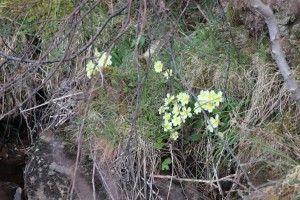 The vivid white blossoms of blackthorn are now conspicuous in hedgerows or woodland margins. The cascade of white flowers holds promise later in the year for the “Food for Free” enthusiasts. The berries of blackthorn – called sloes – are a main component of sloe gin, but there are always variations worth trying such as sloe whisky or even sloe vodka. The problem is leaving the resulting drinks long enough for them to mature, sometime over two months, without being tempted to sample some. In the last few years devotees of this free larder seem to be dwindling although the well established bramble , blackberries, patches are still often frequented. This lack of interest has not been reflected in the publishing world as there are still books coming out on a regular basis that describe how to tap into the “wild harvest”. Some of the books cover the cooking element whilst others also give the background of folk lore and legend as well as the natural history side.
The vivid white blossoms of blackthorn are now conspicuous in hedgerows or woodland margins. The cascade of white flowers holds promise later in the year for the “Food for Free” enthusiasts. The berries of blackthorn – called sloes – are a main component of sloe gin, but there are always variations worth trying such as sloe whisky or even sloe vodka. The problem is leaving the resulting drinks long enough for them to mature, sometime over two months, without being tempted to sample some. In the last few years devotees of this free larder seem to be dwindling although the well established bramble , blackberries, patches are still often frequented. This lack of interest has not been reflected in the publishing world as there are still books coming out on a regular basis that describe how to tap into the “wild harvest”. Some of the books cover the cooking element whilst others also give the background of folk lore and legend as well as the natural history side.
However, whilst the blackthorn blossoms may be showy in many parts, the dominant colour in the countryside at present is undoubtedly yellow. The sources are very varied, from trees to primroses, but, wherever they are, they lighten the scene that is still rather drab after the winter, albeit the mild one we have just had. Perhaps the most impressive and widespread are the willows. There are many different types which means they have the bright yellow pollen masses from mid March to well into the summer months. This variation is very fortunate for the abundance of insects that are attracted to the pollen and the birds that take advantage of the situation. The first of the migrant warblers to come in, both have arrived from Africa in the last couple of weeks, are the willow warbler and chiffchaff. They soon find this rich source of insect food and so much so that the willows are good places to look, or listen, for these first birds that are exhausted after their long migration.
Although willows are widespread the most frequent source of yellow blossoms must surely be from the whins, often called gorse. The whin bushes along the coast, such as the various firths around Inverness, are relatively milder than elsewhere during the winter, especially the last one, so the bushes are in flower virtually all the year round. As the bushes are evergreen they attract the first nesting birds of the season because of the cover. There are some early nesting birds that take advantage of this and one that is uncommon breeds on Drummossie Moor just south of Inverness. It is the stonechat that stays within us all the year round. The recent clearance of whins by machinery over large parts of this moorland was ill timed as far as breeding birds are concerned, but nobody seemed bothered. There cannot be a more useful plant than the whins from a very wide point of view. Other yellow flowers that are now at their best are those of primroses and in some areas they are now quite spectacular. The large areas of woodland dominated by primroses, along the west side of Loch Ness is well worth seeing. Primroses can be found in a wide variety of places from roadsides to the edge of burns. The primroses in the photograph are at my favourite place for seeing them. They are on the edge of a burn and are, unusually, under a small group of aspen trees that are uncommon in the Highlands. Primroses on roadside verges generally mean that the area was once woodland as they are mainly a woodland plant.
Tags: highland flora
